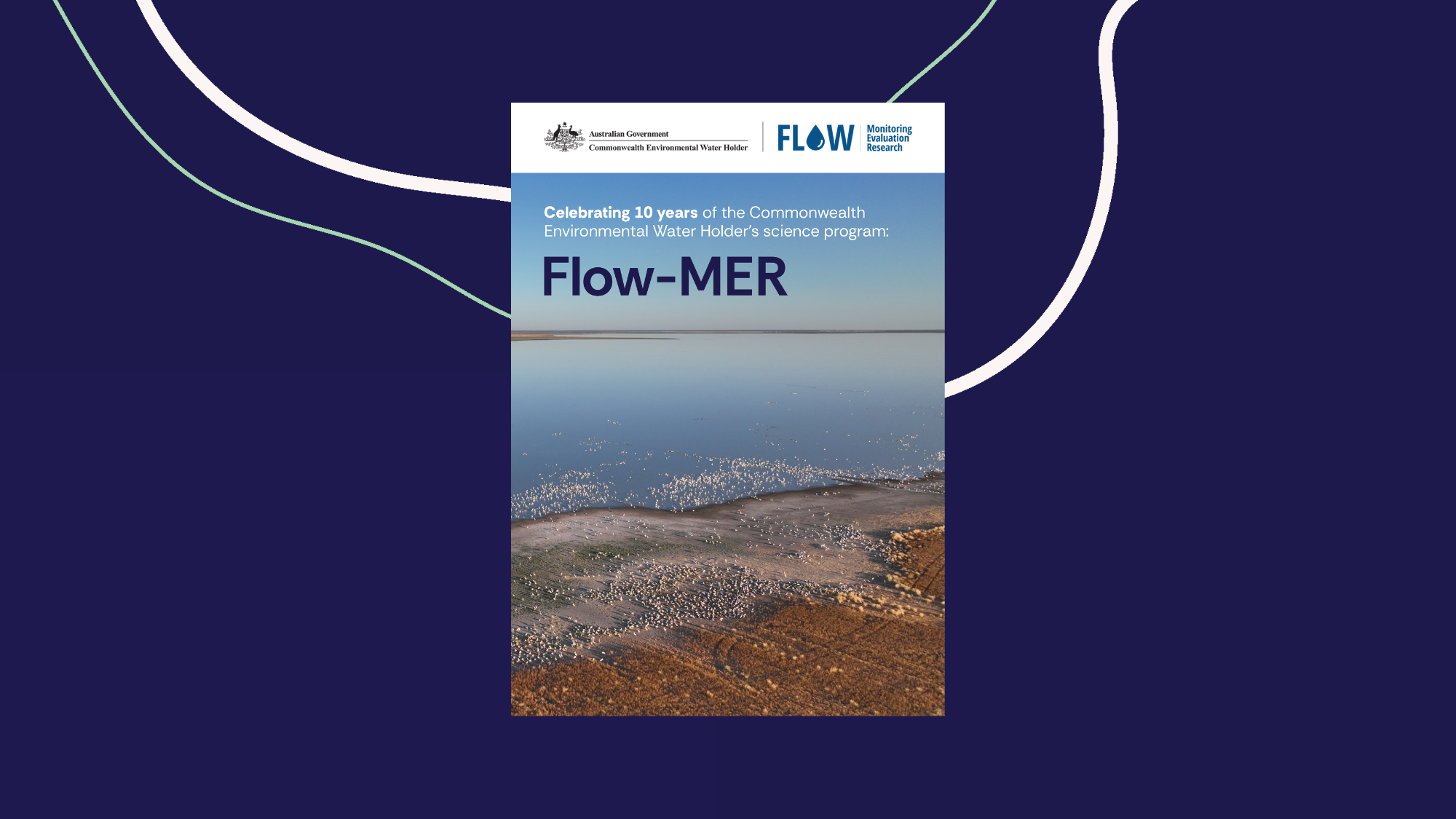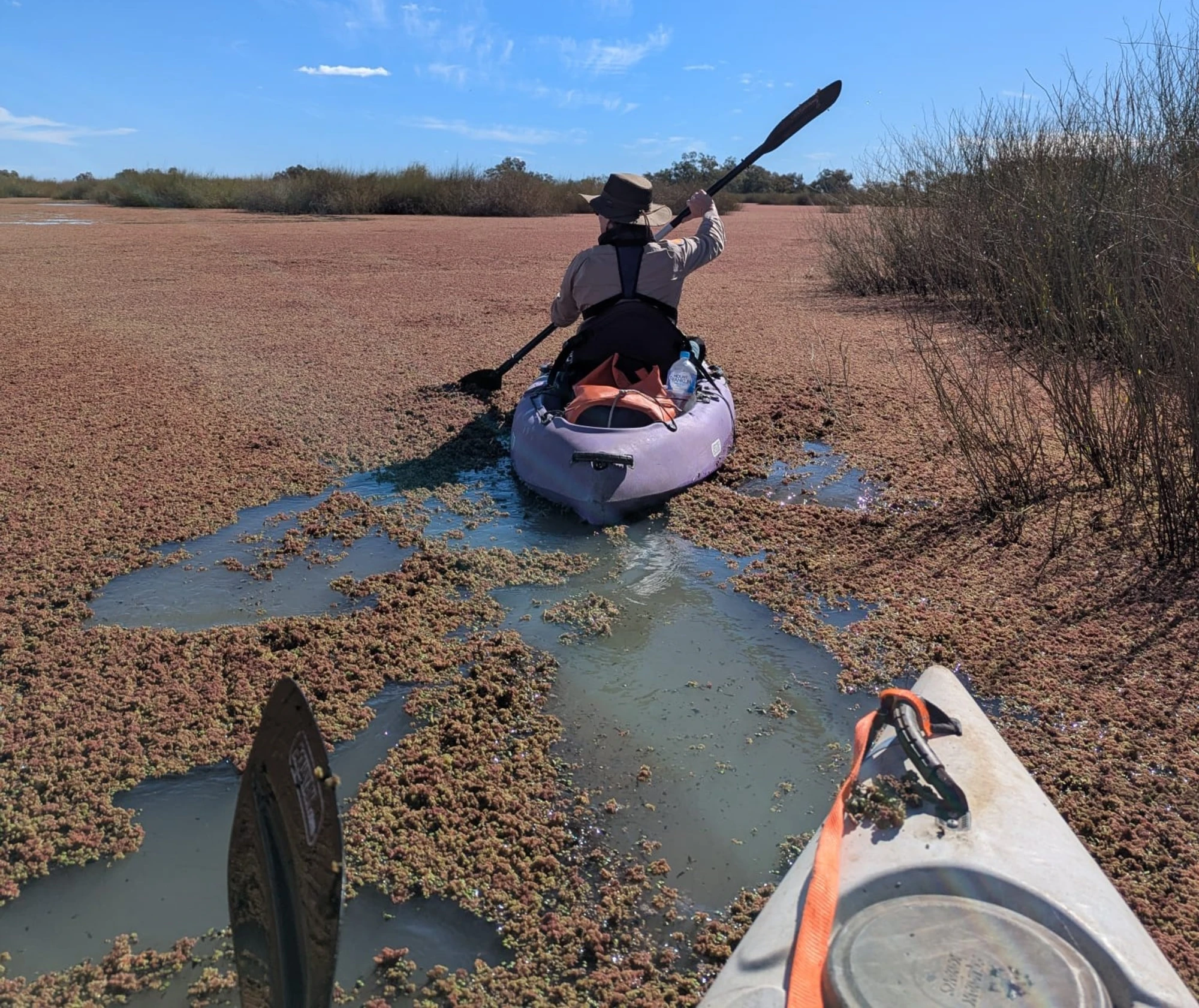
Wiradjuri Artist Rebecca Salcole
Acknowledgement of Country
The Flow-MER Program team acknowledges the First Nations communities of the Murray–Darling Basin and pays respect to Elders past and present.
We acknowledge First Nations people as the Traditional Owners of the land, water and sky Country across the Basin and value the expertise, wisdom and enduring connections that have informed their care for Country over millennia. We recognise the intrinsic connection of First Nations people to Country, and we value the enduring cultural, social, environmental, spiritual, and economic connection to the rivers, wetlands, and floodplains of the Basin.
We are committed to working with First Nations people across the Murray–Darling Basin to build relationships in a meaningful and genuine way to support and empower them in reaching their aspirations.
The Flow-MER Program
Flow-MER is the Commonwealth Environmental Water Holder’s science program, working in partnership with scientists, water managers and communities across the Murray–Darling Basin. Our aim is to understand how our rivers, wetlands, floodplains, and the plants and animals depending on them, are responding to Commonwealth environmental water.
Environmental water is water used to keep our rivers, wetlands and floodplains healthy, and is important for the animals, plants, and people that depend on them.
The Murray–Darling Basin is the largest and most complex river system in Australia. It covers 1 million square kilometres of south-eastern Australia, across New South Wales, Queensland, South Australia, Victoria and the Australian Capital Territory.
Flow-Monitoring, Evaluation and Research (Flow-MER) is the Commonwealth Environmental Water Holder’s (CEWH's) Science Program to inform adaptive management of Commonwealth environmental water in the Murray–Darling Basin. The Flow-MER Program supports the CEWH's work to protect and restore the Basin's water-dependent ecosystems.

Our work: Monitoring, evaluation and research
Across the Murray–Darling Basin
We use monitoring, evaluation and research to assess environmental outcomes and inform adaptive management, using the below indicators that reflect the health of the Basin.

River Flows and Connectivity
The River Flows and Connectivity Theme evaluates how Commonwealth environmental water helps restore flow patterns and improve hydrological connectivity in water-dependent ecosystems across the Basin.
Waterbirds
The Waterbird Theme evaluates the impact of Commonwealth environmental water on maintaining waterbird populations and habitats site scale, within River Systems, and at whole-of-Basin.
Native Vegetation
The Native Vegetation Theme at the Basin scale evaluates how Commonwealth environmental water supports the protection and restoration of water-dependent vegetation, enhancing its extent and condition in actively managed floodplain areas.
Cultural Outcomes
Cultural Outcomes Theme evaluation examines how Commonwealth environmental water contributes to meeting Cultural obligations to care for Country, focusing on cultural indicators, places, and activities that are impacted by environmental water.
Native Fish
The Native Fish Theme evaluation at the Basin scale assesses how Commonwealth environmental water supports the restoration of fish populations and biodiversity.
River Systems
We also work along 10 river systems within the Basin, conducting targeted monitoring and research to understand local ecosystem responses and inform water management practices.
First Nations Knowledge
and Science
First Nations people have a deep and lasting connection to their lands and waters. Their knowledge and science meant their Country was looked after. Since European colonisation First Nations people have mostly been left out of managing and making decisions about their Country.
It is important we consider different knowledges to improve how we deliver water. We have listened to First Nations people we work with and understand that they need to be included in our monitoring, evaluation and research. Knowledges shared by First Nations people will help achieve better environmental outcomes.
We are building connections with First Nations people to understand how Flow-MER can support First Nations people to care for their Country according to their lore and values. We have dedicated funding to support research and monitoring activities important to First Nations people.

Latest News
%20flowers-%20(photo%20credit-%20Rebekah%20Grieger).jpg)
Finding lignum shrublands: a vital habitat for nesting birds
In the Namoi River system, much of the floodplain vegetation, including lignum shrublands, has been replaced by irrigated and dryland crops. While many areas have changed, resilient patches of lignum still thrive along roadways and on private farms, offering valuable habitats.
%20.jpg)
Rugged giants and tiny seedlings: resilience and establishment of river red gums on the Barwon River
River red gums are iconic trees of the Murray–Darling Basin, well known as the giants towering over waterways for hundreds of years. Researchers are concerned about the ongoing survival of these trees due to a lack of recorded seedlings, especially in the northern Basin.

Celebrating 10 years of the Commonwealth Environmental Water Holder’s science program: Flow-MER (digital booklet)
This digital booklet captures that journey. It reflects the progress, partnerships, and knowledge built through Flow-MER – the Basin’s largest and longest-running environmental water science program.




